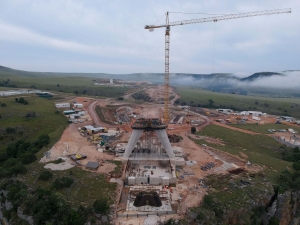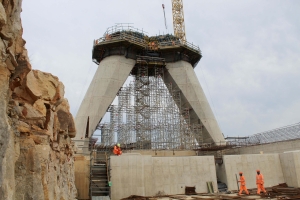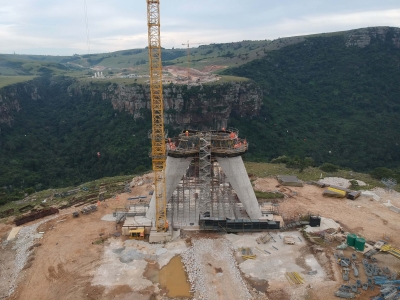The 580m-long cable-stayed bridge will cross the 198m-deep Msikaba Gorge as part of the new N2 toll road between Port Edward and Umtata. The South African National Roads Agency Limited (Sanral) project is being built by the CME JV joint venture, a partnership between Concor Construction and MECSA Construction.

Above: The Msikaba Bridge Project on the new N2 toll road between Port Edward and Umtata achieved an engineering milestone this month, as the legs of the bridge’s south pylon were hydraulically jacked apart.
The two legs make up the first 20m of the inverted Y-shaped pylon, said CMEJV project director Laurence Savage, and are being built without any lateral support as free cantilevers.

Once completed four lanes of vehicles and a pedestrian walkway on either side will pass beneath the legs at the start and end of the bridge deck.
“The jacking apart of the legs countered the bending moment at the bases of the cantilever legs,” said Savage. “In layman’s terms, the jacking eradicated the effect of the legs bending towards each other; as engineers would see this, the legs are effectively vertical due to the jacking process.”
The bridge includes two pylons that will stand 128m high on each side of the gorge; the pylons will support the bridge deck using a network of 34 cable tendons. “These cables then run from the top of the pylons back into anchor blocks located 100 metres to the rear of the respective pylons,” said Savage. Each of the four anchor blocks is made up of over 1,600t of structural reinforced and mass concrete and extend 17m into the ground.
Savage said that the lateral support was installed on the sixth lift of the pylon structure, after 520m3 of concrete had been poured to reach a height of 20m.

“Two sets of hydraulic jacks were installed in parallel to each other and a jacking force of 1,750 kilonewtons (kN) applied to the two pylon legs to counter the bending moment for the freestanding cantilever legs,” he said.
To achieve the required force, the two 150t hydraulic jacks were loaded to 90t, developing a pressure of 41MPa. The jacking was done on 5MPa intervals, and deflections of the structure were monitored using dial gauges and surveying.
Savage added that a key consideration was the punching force on the flat face of the pylon legs due to the jack load. This also dictated the size of the bearing plates affixed to the inside of the legs, enabling a dissipation of the force across the appropriate surface area. This avoided any damage to the structure due to loading of the concrete surface.
“The jacks only have a 50 mm stroke, which required the installations to be exact – as the 41MPa pressure had to be achieved before the jack ran out of stroke length,” he said. “The base plates were installed on the pylon leg structure with 29mm non-shrink grout minimising the use of the stroke length.”
After the lateral support was aligned and seated, a grout biscuit was cast which served two key functions. Firstly, it absorbed any tolerances in the installation after the initial base plate installation and secondly, it assisted with the removal of the lateral support. Breaking out the grout biscuit released the pressure in the lateral support, once the seventh lift was cast and the legs permanently locked together.
“The temperature of the pylon structure and lateral support was measured to ensure an average of 22°C, to limit any unforeseen changes in force due to changes in the temperature during the construction cycle casting lift seven,” he said. “The lateral support was wrapped in a 25 mm thick thermal blanket to limit temperature change movements and any resulting changes in prop forces.”
The lateral support was locked into place using a two-part system: the locking ring on the hydraulic jack, and the locking ring on the super-shore jack housing. The preparation for the jacking took three months of planning and analysis, while the setup was conducted over nine days. The actual jacking process was complete in less than eight hours from commencement.
Savaged said that the total movement of the pylon after jacking totalled 23 mm at a force of 1,750kN – which was within the design parameters. The casting of lift seven was then carried out to lock in the release of the moment.




